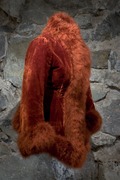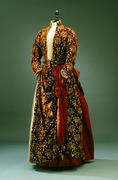Augusta Lundin
Augusta Lundin (born June 13, 1840 in Kristianstad , † February 20, 1919 in Stockholm ) was a Swedish fashion designer , milliner , tailor and fashion house owner .
Life
Augusta Lundin grew up as the eldest daughter of the tailor Anders Lundin and his wife Christina Andersdotter in Kristianstad, together with four sisters and a brother. The daughters were homeschooled and Augusta and her younger sister Hulda learned their fatherly profession.
At the age of 23 she moved to Stockholm, where she worked in Emma Hellgren's hat fashion house from 1863 to 1865 and in a fashion trading company from 1865 to 1867, before setting up a small fashion studio in three small rooms at 30 Malmskillnadsgatan. In the early days, customers brought their own fabrics from which they made going out, party and ball gowns. With the translation of the German magazines Der Bazar und Modenwelt into Swedish ( Nya Bazaren und Freja ) in the early 1970s, interest in fashion grew, and Lundin's fashion house met the demand for elaborate embroidery.
Decisive for the growing success in the beginning was on the one hand the support from her sisters - her younger sister Hulda Lundin had founded a school in Stockholm to train girls and young women in the craft - and her close contact with Otto Gustaf Bobergh, who for many years long worked with the Parisian fashion designer Charles Frederick Worth . Through him she was able to find out about new ideas and fashion impulses from Paris. Inspired by French fashion, she began designing her own models and producing licensed copies. From 1874 she traveled to Paris herself every year and bought fabrics and other materials. In the same year, she redesigned the sewing shop into a fashion magazine with sales. In 1886, on behalf of the Swedish Reform Clothing Society (Svenska drägereformföreningen), she designed a costume that corresponded to the aims of reform clothing , a loosely falling piece of clothing without a corset or tourniquet .
Jacket for Sophia von Nassau , around 1887
Train for Joséphine de Beauharnais , early 19th century.
Jacket for Sophia von Nassau , around 1887
In 1887, Lundin and the expanding company moved into three floors in Brunkebergstorg 2. They introduced numerous innovations in their company, such as fixed working hours from 9 a.m. to 7 p.m. in the 1890s, shorter than other workplaces in the same branch. Food was prepared for the staff in a large kitchen. At the same time, she paid her employees better than usual at similar companies and gave the seamstresses two weeks' vacation every summer. She adopted the French way of working to have each part of a garment sewn separately in its own department. She hired male tailors for the first time in the 1890s.
Augusta Lundin is considered to be Sweden's first fashion designer. Stockholm had many fashion houses in the early 20th century, but Augusta Lundin's studio was the leading address. Her fashion studio was a center of Parisian fashion in Sweden from the mid-1870s until the First World War and she was known as the "Stockholm Dior". The company supplied the royal family from 1892 as a royal purveyor of Queen Sofia and Josephine of Leuchtenberg . Oscar II ordered dresses from her studio every year as a Christmas present for the ladies-in-waiting. Lundin's customers included the actresses known at the time, the ladies of Stockholm society and Selma Lagerlöf . Customers from all over the country visited her fashion company, the business was also known abroad and orders came from Norway, Finland and St. Petersburg. In 1908 the fashion magazine moved to larger premises at 20 Brunkebergstorg. In 1914 Augusta Lundin employed 175 seamstresses and four dressmakers.
Dress for Viktoria von Baden , 1905
Dress for Wilhelmina von Hallwyl , 1886
When Augusta Lundin died in 1919, her sister KA Bergholm inherited her company, which was called Augusta Lundin AB and had 200 employees. Two years later the company moved to new premises on Kungsträdgårdsgatan 12. In 1939 the fashion house became "Maison Augusta" at Linnégatan 5, but closed a few years later.
Augusta Lundin's robes and festive evening dresses are exhibited in various museums, such as the Sörmlands museum in Nyköping, the Kulturmagasinet in Helsingborg, the Nordic Museum in Stockholm, the Röhsska museet in Gothenburg, the Upplandsmuseet in Uppsala and the Västmanlands läns museum in Västerås. The silver-gray brocade dress that she created for Selma Lagerlöf's Nobel Prize ceremony is on display in the Mårbacka Museum in Sunne .
Web links
- Augusta Lundin in the Svenskt kvinnobiografiskt lexikon (Swedish)
- Augusta Lundin in the Svenskt biografiskt lexikon . Volume 24 (1982-1984), p. 328 (Swedish)
Individual evidence
- ↑ a b c d e f Gunhild Engholm: Augusta Lundin . In: Svenskt biografiskt lexikon (Swedish). Retrieved September 16, 2018
- ↑ a b c Josefin Kilner: Embroideries and Flower Silk Laces - Swedish Fashion in the Time of the Art Nouveau and Jugend Period . In: First Monday (English). Retrieved September 19, 2018
- ↑ a b c d Emma Severinsson: Augusta Lundin . In: Svenskt kvinnobiografiskt lexikon (Swedish). Retrieved September 16, 2018
- ↑ a b c Anna Hellsten: Klädsam historia , from September 1, 2012. In: Sydsvenskan (Swedish). Retrieved September 16, 2018
- ↑ Nordiska museet: Klädning (Swedish). Retrieved September 19, 2018
- ↑ a b Av Marie Söhrman, Margareta Wallin Wictorin: I en garderob på Mårbacka. Selma Lagerlöfs nobelklänning (Swedish). Retrieved September 19, 2018
- ^ Sörmlands museums: Augusta Lundin (Swedish). Retrieved September 19, 2018
- ↑ Kulturmagasinet: 1086-53 :: klänning (Swedish). Retrieved September 19, 2018
- ↑ DigitaltMuseum: Klädning (Swedish). Retrieved September 19, 2018
| personal data | |
|---|---|
| SURNAME | Lundin, Augusta |
| BRIEF DESCRIPTION | Swedish fashion designer |
| DATE OF BIRTH | June 13, 1840 |
| PLACE OF BIRTH | Kristianstad |
| DATE OF DEATH | February 20, 1919 |
| Place of death | Stockholm |











